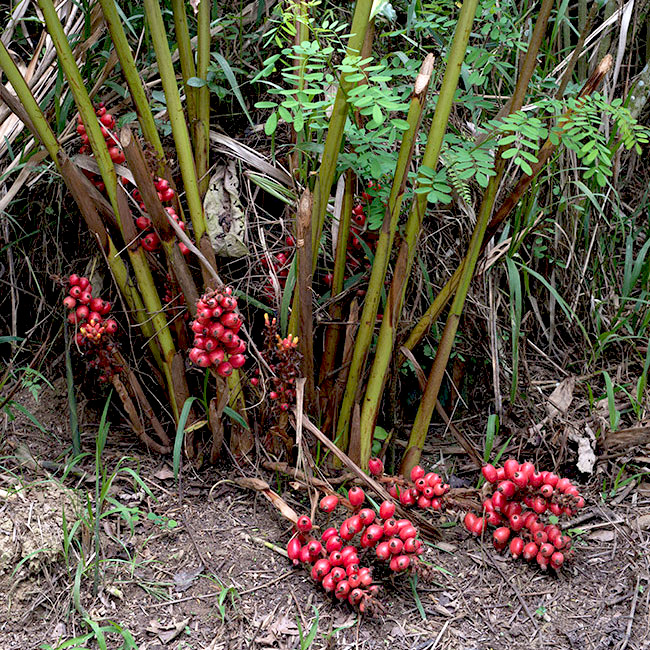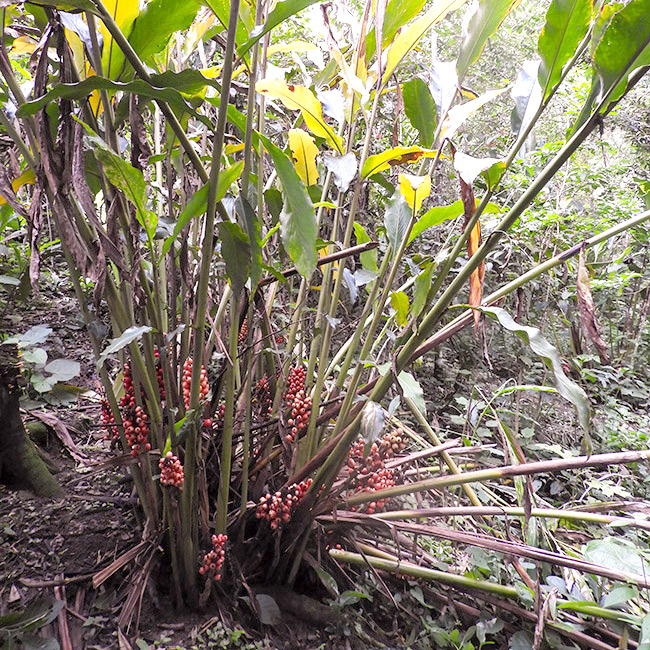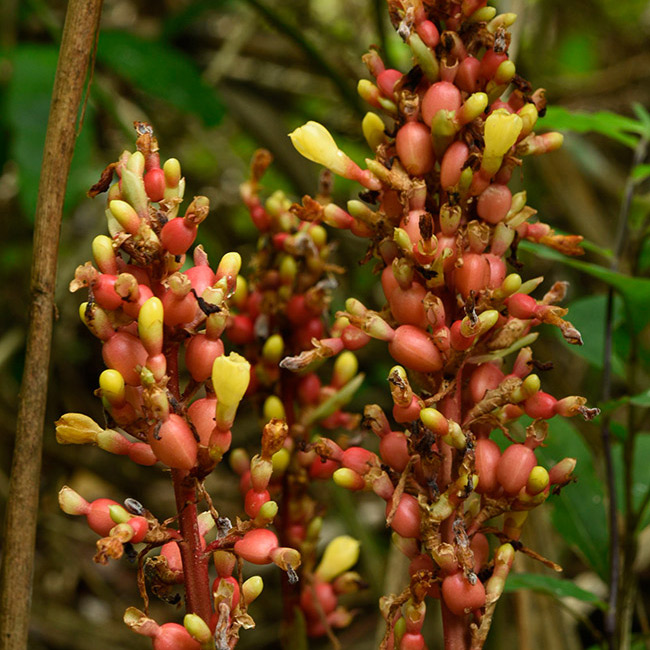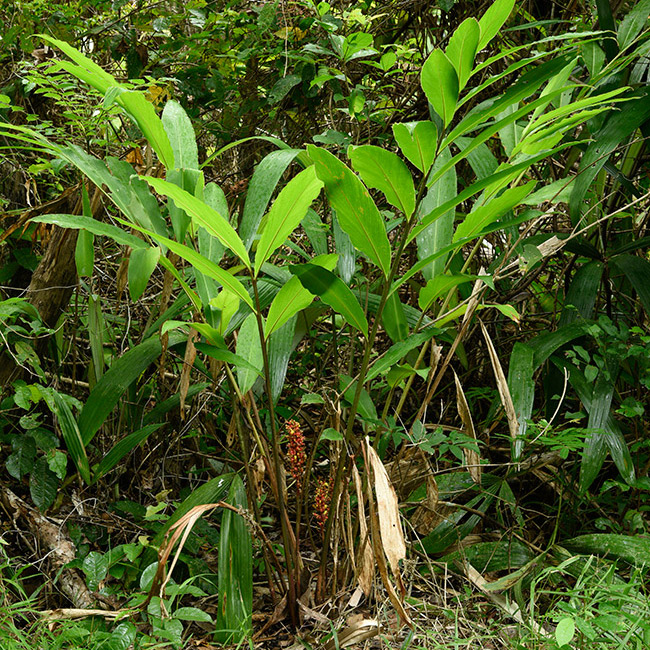Renealmia, edible Mayan plant, found wild in Yaxha park
 |
 |
|
Renealmia near Q’eqchi’ Mayan |
Renealmia near the house of Senaida’s |
During the last four years we have found Renealmia in many kitchen gardens in remote areas within one to two hours drive into the mountains in the Q’eqchi’ Mayan areas around Senahu, Alta Verapaz.
During 2018 with the help of Park Ranger Teco (Moises Daniel Perez Diaz) and help of Senaida Ba (FLAAR Mesoamerica), we found Renealmia in Parque Nacional Yaxha Nakum Naranjo.
 |
 |
|
Here is the first Renealmia plant we found in Parque Nacional Yaxha Nakum Naranjo. We will now check past plant lists for the park to see if earlier botanists noticed this plant. Our goal is to contribute to future Plan Maestro plant lists. Plus the goal is to make lists of all edible wild plants within the park. Then the same species can be found outside the park to help local people improve their diet. Our goal is also to make lists of all utilitarian wild plants within the park. Then the same plant can be found outside the park so that we can prepare projects to assist local people to improve their income by producing products to sell to tourists that are made of renewable natural resources. Both images are by Dr Nicholas Hellmuth. |
|
Since Renealmia can provide a dye colorant, lots of potential medicinal cures, and since the aril around the fruit is edible, we would like to introduce this multi-use plant. It is a lot more healthy than junk food. We start with this list of suggested reading.
We are preparing a complete botanical report on Renealmia of Guatemala which should be ready within 2 months.
PDF, Articles, Books on Renealmia alpinia
- n.d.
- Plantas medicinales en huertos familiares. 12 pages.
Suggests that the Renealmia in Q’eqchi’ Mayan house gardens is Renealmia aromatica (Aubl.) Griseb. (pages 8 and 9).
Request it online:
https://www.researchgate.net/publication/265454758_Plantas_Medicinales_en_Huertos_Familiares
- 2017
- Traditional Uses of Renealmia species fruit, by Q’eqchi’ Mayan people, Alta Verapaz, Guatemala. Notes by Senaida Ba, FLAAR Mesoamerica. All the material in her notes has been absorbed in the present discussion of all the species names.
- 2003
- Los Recursos Vegetales Aromáticos en Latinoamérica. Su aprovechamiento industrial para la producción de aromas y sabores. 2nd edition. CYTED. Buenos Aires. 417 pages.
- 2000
- Checklist of the Vascular Plants of Belize with common names and uses. The New York Botanical Garden Press. 246 pages.
A checklist is helpful because it is a long list in a not overly long monograph. Inclusion of uses is very helpful. But downside of a checklist is no description of what eco-system the plants focus on, and although the bibliography is better than most other botanical monographs I have read in the last 20 years, there are no citations for individual plants (same problem with Parker’s Trees of Guatemala, but at least by tree family she lists the monographs, articles, and other sources, albeit not plant-species by species). Nonetheless, sure would be a help to have a book like Balick Nee and Atha for Peten.
Lundell’s many years work in Peten are awesome but other than his 1937 opus, none of his 1960’s research is in an orderly fashion: it is all splattered helter- skelter.
Sold online:
www.amazon.com/Checklist-Vascular-Plants-Belize-Botanical/dp/0893274402
- 2015
- Messages from the Gods: A guide to the useful plants of Belize. New York Botanical Garden, Oxford University Press. 539 pages.
So twice the length of the Checklist, in part because this publication includes color photos and some drawings.
“Renealmia cf. alpina (Rottb.) Maas, shma bui (Mayan). The fruit eaten as a food when squeezed into water, releasing a yellow juice that is consumed warm as a soup.”
Since this is a book on ethnomedicine, there is no mention of any Renealmia as a dye colorant. For Renealmia aromatica they ascribe multiple medicinal uses (page 163). No other Renealmia species is listed.
A helpful book on ethnomedicinal plants of one area of Belize by a capable and experienced botanist together with a local healer.
Available online:
www.amazon.com/Messages-Gods-Useful-Plants-Belize/dp/0199965765
- 2016
- The Forest of the Lacandon Maya. An Ethnobotanical Guide. Springer. 379 pages.
p. 172 Renealmia alpinia or R. thyrsoidea. The northern Lacandones only use the leaves for food preparation to pat out tortillas but it is also mentioned mukbil wah, large, baked tamale’ as though the leaves are used to wrap the tamale for cooking???. R mexicana is found in the southern Lacandon territory where it is used for medicinal purposes.
In the distribution maps of Maas 1977, there is no Renealmia thyrsoidea anywhere in Mexico and also totally absent from Belize, Honduras, El Salvador… So it would help if the capable Chiapas botanists could document the botanical names of Renealmia in their state. As according to “the Bible of Renealmia” only in Chiapas you find only: Renealmia alpina (distribution map Fig. 58, page 148).
I must admit that even with a few flowers and immature fruits, it’s tough to Identify the species of the single plant we found at the Yaxha park area (normally in Alta Verapaz it grows in crowded thickets with dozens and scores of plants everywhere around).
No mention of use as a colorant.
Sold online:
www.springer.com/la/book/9781461491101
- 2016
- Inventario florístico de la comunidad lacandona de Nahá, Chiapas, México. Botanical Sciences. Vol. 94, No. 1. Pages 157-184.
Available online:
https://studylib.es/doc/5358777/inventario-flor%C3%ADstico-de-la-comunidad-lacandona-de-nah%C3%A1--
- 2008
- A Field Guide to Plants of Costa Rica. Oxford University Press. 544 pages.
This is the source of Suzanne Cook’s citation on description of Renealmia (2016: 172) in the Lacandon Maya area of Chiapas where Cook did her capable research.
What would help is a complete botanical report on Renealmia species, with full resolution, full color digital photographs, based on first-hand observation in Chiapas, Tabasco, Campeche, Quintana Roo, Belize, Peten, Alta Verapaz, Izabal as a starter (plus other areas of Guatemala where Renealmia occur, such as the Costa Sur).
Sold online:
www.amazon.com/Field-Guide-Plants-Costa-Rica/dp/019518825X
- 2014
- Traditional use of the genus Renealmia and Renealmia alpinia (Rottb.) Maas (Zingiberaceae)- a review in the treatment of snakebites. Asian pacific Journal of Tropical Medicine. Vol. 7, No. 1. Pages 574-582.
Available online:
www.researchgate.net/publication/266948455_Traditional_use_of_the_genus_Renealmia_and_Renealmia_alpinia_Rottb_Maas_Zingiberaceae-a_review_in_the_treatment_of_snakebites
- 1977
- Cholti-Lacandon (Chiapas) and Petén-Ytzá Agriculture, Settlement Pattern and Population. In: Social Process in Maya Prehistory, Studies in honour of Sir Eric Thompson. Ed. Norman Hammond. Pages 421-446.
It would be helpful, now that the local name in Q’eqchi’ Mayan and Lacandon Maya are known, would be to find the name of all Renealmia species in Mopan Maya, Chol and Chorti Maya, and double-check Cholti Maya also. Next, do field and linguistic research to find out why Renealmia is not mentioned in studies of the Peten Itza of Central Peten: since Renealmia is present in Parque Nacional Yaxha Nakum Naranjo.
FLAAR has scanned this to make it available at no cost.
Available online:
http://maya-archaeology.org/FLAAR_Reports_on_Mayan_archaeology_Iconography_publications_books_articles/84_Cholti-Lacandon_Maya_and_Peten-Ytza_Maya_Agricultrure_Settlement_Pattern_Population_Nicholas_Hellmuth_FLAAR_1977.pdf
- 2008
- Systematics and biogeography of Renealmia L.F. (Zingiberaceae) based on nuclear and chloroplast DNA squences. Gothenburg University, Royal botanical Garden Edinburgh and Univeristy of Oxford. 28 pages.
Available online:
https://bioenv.gu.se/digitalAssets/1325/1325015_marion-jannes.pdf
- 2005
- The molecular phylogeny of Alpinia (Zingiberaceae): a complex and polyphyletic genus of gingers. American Journal of Botany. Vol. 92, No. 1. Pages 167-178.
Available online:
www.amjbot.org/content/92/1/167.full.pdf+html
- 2006
- Aspectos florísticos de Lacanhá Chansayab, selva lacandona, Chiapas. Act. Bot. Mex. No. 77.
Available online:
www.scielo.org.mx/scielo.php?script=sci_arttext&pid=S0187-71512006000400005
- 1937
- The vegetation of Petén: with an appendix studies of Mexican and Central American plants. Carnegie Institution of Washington. 244 pages.
Considering that Renealmia is a major medicinal plant and listed by Standley & Steyermark, Lundell, etc. I was expecting to find it in the comprehensive book by on ethnomedicine of the Peten Itza. But there is no idex; and under the family Zingiberaceae there is no Renealmia genus or any species at all (Atran Lois and Ucan 2004: 196).
Available online:
https://babel.hathitrust.org/cgi/pt?id=mdp.39015012268689;view=1up;seq=7
- 1938
- Plants probably utilized by the Old Empire Maya of Peten and adjacent Lowlands. Papers of the Michigan Academy of Sciences, Arts, and Letters. University of Michigan, Ann Arbor. Vol. 24. Pages 37-56.
- 2003
- Renealmia alpinia (Rottb.) Maas (Zingiberaceae): planta comestible de la Sierra Norte de Puebla (México). Anales Jardín Botánico de Madrid. Vol. 60, No. 1. Pages 183-187.
Available online:
www.researchgate.net/publication/26523545_Renealmia_alpinia_Rottb_Maas_Zingiberaceae_planta_comestible_de_la_Sierra_Norte_de_Puebla_Mexico
- 1990
- Notes on New World Zingiberaceae: IV: Some new species of Costus and Renealmia. Notes RBG Edinb. Vol. 46, No. 3. Pages 307-320.
Available online:
www.repository.naturalis.nl/document/572856
- 2001
- Zingiberaceae Lindl. In: W.D. Stevens, C. Ulloa-Ulloa, A. Pool and O.M. Montiel (eds.), Flora de Nicaragua. Monographs in Systematic Botany from The Missouri Botanical Garden. Vol. 85, No. 3. Pages 2549-2554.
Helpful contribution by capable botanist. However “Central America” is often treated as a single area without giving much or any consideration to Guatemala (page 18 is a good example). So to make a list of what Renealmia species are in Guatemala you have to do your own homework.
For example, in the list of local names, the word Guatemala appears NOWHERE (pages 19-20). Yet there are 21 Mayan languages in Guatemala, plus Xinca, and post-conquest Garifuna. Of the 21 Mayan languages, Renealmia grows in Q’eqchi’, Itza, and surely other language areas. So why is an eminent botanical opus not including field work and linguistic knowledge of one of the larger countries of Central America?
I would also question whether either of the authors has field experience in Guatemala or Belize. The word Belize is barely mentioned. A SEARCH VIA “FIND” TURNS UP ZERO, I repeat ZERO, use of the word Belize.
- 2003
- Renealmia alpinia (Rottb.) Maas (Zingiberaceae): planta comestible de la
Sierra Norte de Puebla (México). Anales Jará. Bot. Madrid. Vol. 60, No. 1. Pages 183-187.
Available online:
http://digital.csic.es/bitstream/10261/2482/1/Renealmia.pdf
- 1982
- The Plant World of the Sixteenth- and Seventeenth-Century Lowland Maya. In Maya Subsistence Studies in Memory of Dennis E. Puleston, Kent V. Flannery, editor. Academic Press, New York and London. Pages 239-273.
Available online:
www.researchgate.net/publication/289055186_The_Plant_World_of_the_Sixteenth-_and_Seventeenth-Century_Lowland_Maya
- 2008
- Plant diversity assessment in the Yaxchilán natural monument, Chiapas, Mexico. Bol. Soc. Bot. Mex. Vol. 83. Pages 53-76.
Available online:
www.researchgate.net/publication/262589806_Plant_diversity_assessment_in_the_Yaxchilan_Natural_Monument_Chiapas_Mexico
- 2016
- Caracterización morfológica y evaluación de la germinación de semillas de dos especies tintóreas de la provincia de Zamora Chinchipe. Universidad Técnica Particular de Loja. 57 pages.
Available online:
http://dspace.utpl.edu.ec/bitstream/123456789/16261/1/Monta%C3%B1o%20Gonz%C3%A1lez%2C%20Iliana%20Elizabeth.pdf
- 2015
- Renealmia L.f.: aspectos botânicos, ecológicos, farmacológicos e agronômicos. Rev. Bras. Pl. Med., Campinas. Vol. 17, No.2. Pages 274-290.
Available online:
www.scielo.br/pdf/rbpm/v17n2/1516-0572-rbpm-17-2-0274.pdf
Typical discussion of Renealmia in South America and NOT in Mesoamerica.
- 2011
- Extracción, pruebas de estabilidad y análisis químico preliminar de la fracción colorante obtenido a partir del exocarpo del fruto de Renealmia alpinia. La Granja. Vol. 13, No. 1. Pages 13-20.
Available online:
www.researchgate.net/publication/318391747_Extraccion_pruebas_de_estabilidad_y_analisis_quimico_preliminar_de_la_fraccion_
colorante_obtenido_a_partir_del_exocarpo_del_fruto_de_Renealmia_Alpinia
- 2005
- Vegetación terrestre. En: Bueno, J., Alvarez, F. y S. Santigo (Eds.) Biodiversidad del Estado de Tabasco. Instituto de Biología, UNAM-CONABIO. Pages 65-110.
Available online:
http://bioteca.biodiversidad.gob.mx/janium/Documentos/ETAPA01/PDF/4796/4796.pdf
- 1952
- Flora of Guatemala. Fieldiana: Botany Vol. 24, Part III. Chicago Natural History Museum. 432 pages.
As usual, this helpful monograph series is very weak on material from Peten.
Available online:
https://archive.org/stream/floraofguatemala3fistan/floraofguatemala3fistan_djvu.txt
- 1994
- Flora de Veracruz: Zingiberaceae. Instituto de Ecología, A.C. and University of California. No. 79. 19 pages.
Available online:
www1.inecol.edu.mx/publicaciones/resumeness/flover/79-vovides.pdf
- 1981
- Foods for Early Man. Ceiba. 342 pages.
Most Mayanists, and I for sure, tend to use Lundell’s 1938 article for references to edible and utilitarian plants of the Maya. This 1981 report by Williams, which is a summary of Standley and Steyermark et al over the years, is rarely used. It simply repeats what is already in Standley and Steyermark 1952.
It is reported that the fruits of this or an allied species are used to flavor meat soups in the Petén, also that the leaves covered with tallow are used as bandages for fractures, sprains or superficial inflammation. (page 336). Neither are really certain which species they are supposed to refer to.
- 1972
- A highland maya people and their habitat: the natural history, demography and economy of the K´ekchi. PhD thesis. University of Oregon.
Suggested webpages with photos and information on Renealmia species
http://biogeodb.stri.si.edu/bioinformatics/croat/specie/Renealmia%20alpinia,e,n
Information and photos. But the photos are so small it is embarrassing. How can a research institute of this status (Smithsonian Tropical Research Institute) put onto the internet photos that are only about miniscule 2 centimeters tall EVEN WHEN YOU CLICK ON THE “ENLARGE” OPTION!
www.discoverlife.org/mp/20q?search=Renealmia+alpinia
Photos and map location.
www.theplantlist.org/tpl1.1/record/kew-260859
List of lots of synonyms.
http://tropical.theferns.info/viewtropical.php?id=Renealmia+alpinia
Information and photos.
Updated Jan. 2019 with discussion of Renealmia alpinia by Nicholas Hellmuth and additional botanical monographs.
First posted, February 2018. Bibliography by Marcella Sarti, FLAAR Mesoamerica.































